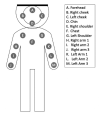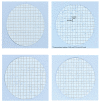The Efficacy of High-Volume Evacuators and Extraoral Vacuum Aspirators in Reducing Aerosol and Droplet in Ultrasonic Scaling Procedures during the COVID-19 Pandemic
- PMID: 35016239
- PMCID: PMC9683881
- DOI: 10.1055/s-0041-1739448
The Efficacy of High-Volume Evacuators and Extraoral Vacuum Aspirators in Reducing Aerosol and Droplet in Ultrasonic Scaling Procedures during the COVID-19 Pandemic
Abstract
Objective: SARS-CoV-2 can be carried by aerosols and droplets produced during dental procedures, particularly by the use of high-speed handpieces, air-water syringes, and ultrasonic scalers. High-volume evacuators (HVEs) and extraoral vacuum aspirators (EOVAs) reduce such particles. However, there is limited data on their efficacy. This study aimed to determine the efficacy of HVE and EOVA in reducing aerosols and droplets during ultrasonic scaling procedures.
Materials and methods: Three ultrasonic scaling simulations were conducted on mannequins: 1. saliva ejector (SE) was used alone (control); 2. SE was used in combination with HVE; and 3. SE was used in combination with HVE and EOVA. Paper filters were placed on the operator's and assistant's face shields and bodies, and the contamination of aerosols and droplets was measured by counting blue spots on the paper filters.
Statistical analysis: All data were analyzed for normality using the Kolmogorov-Smirnov test. The differences between each method were analyzed using a two-way ANOVA, followed by a posthoc test. The differences were considered statistically significant when p < 0.05.
Result: Using HVE and EOVA reduced aerosols and droplets better than using SE alone or SE and HVE: the posthoc test for contamination revealed a significant difference (p < 0.01). The assistant was subjected to greater contamination than the operator during all three ultrasonic scaling procedures.
Conclusion: The usage of HVE and EOVA significantly reduced aerosols and droplets compared with using SE solely. Using these techniques together could prevent the transmission of airborne disease during dental cleanings, especially COVID-19. Further studies of aerosol-reducing devices are still needed to ensure the safety of dental workers and patients.
The Author(s). This is an open access article published by Thieme under the terms of the Creative Commons Attribution License, permitting unrestricted use, distribution, and reproduction so long as the original work is properly cited. (https://creativecommons.org/licenses/by/4.0/).
Conflict of interest statement
None declared.
Figures



Similar articles
-
Effect of an extraoral scavenging device on eliminating droplets and aerosols generated in ultrasonic supragingival scaling: A randomised clinical trial.Int J Dent Hyg. 2025 Feb;23(1):37-43. doi: 10.1111/idh.12823. Epub 2024 May 21. Int J Dent Hyg. 2025. PMID: 38773892 Clinical Trial.
-
Effectiveness of barrier devices, high-volume evacuators, and extraoral suction devices on reducing dental aerosols for the dental operator: A pilot study.J Am Dent Assoc. 2022 Apr;153(4):309-318.e1. doi: 10.1016/j.adaj.2021.08.011. Epub 2021 Dec 21. J Am Dent Assoc. 2022. PMID: 34952682 Free PMC article.
-
Concern about the risk of aerosol contamination from ultrasonic scaler: a systematic review and meta-analysis.BMC Oral Health. 2024 Apr 5;24(1):417. doi: 10.1186/s12903-024-03996-2. BMC Oral Health. 2024. PMID: 38580933 Free PMC article.
-
Dental high-speed handpiece and ultrasonic scaler aerosol generation levels and the effect of suction and air supply.Infect Control Hosp Epidemiol. 2023 Jun;44(6):926-933. doi: 10.1017/ice.2022.196. Epub 2022 Aug 8. Infect Control Hosp Epidemiol. 2023. PMID: 35938186 Free PMC article.
-
A laboratory comparison of evacuation devices on aerosol reduction.J Dent Hyg. 2002 Summer;76(3):202-6. J Dent Hyg. 2002. PMID: 12271865 Review.
Cited by
-
The Oral Cavity Potentially Serving as a Reservoir for SARS-CoV-2 but Not Necessarily Facilitating the Spread of COVID-19 in Dental Practice.Eur J Dent. 2023 May;17(2):310-318. doi: 10.1055/s-0042-1757909. Epub 2022 Dec 20. Eur J Dent. 2023. PMID: 36539210 Free PMC article.
-
Assessment of Infectious Diseases Risks From Dental Aerosols in Real-World Settings.Open Forum Infect Dis. 2022 Nov 11;9(11):ofac617. doi: 10.1093/ofid/ofac617. eCollection 2022 Nov. Open Forum Infect Dis. 2022. PMID: 36447607 Free PMC article.
-
Characterization of dental dust particles and their pathogenicity to respiratory system: a narrative review.Clin Oral Investig. 2023 May;27(5):1815-1829. doi: 10.1007/s00784-023-04910-w. Epub 2023 Feb 11. Clin Oral Investig. 2023. PMID: 36773127 Free PMC article. Review.
-
Personalized Treatment of Periodontitis in a Patient with McArdle's Disease: The Benefits from Probiotics.Case Rep Dent. 2023 Mar 10;2023:5080384. doi: 10.1155/2023/5080384. eCollection 2023. Case Rep Dent. 2023. PMID: 36937222 Free PMC article.
-
Reduction of aerosol dissemination in a dental area generated by high-speed and scaler ultrasonic devices employing the "Prime Protector".PLoS One. 2023 Aug 3;18(8):e0278791. doi: 10.1371/journal.pone.0278791. eCollection 2023. PLoS One. 2023. PMID: 37535637 Free PMC article.
References
-
- Variant D.What We Know About the ScienceAccessed August 29, 2021 at:https://www.cdc.gov/coronavirus/2019-ncov/variants/delta-variant.html
-
- Transmission of SARS-CoV-2: implications for infection prevention precautionsAccessed: August 29, 2021 at:https://www.who.int/news-room/commentaries/detail/transmission-of-sars-c...
LinkOut - more resources
Full Text Sources
Miscellaneous

